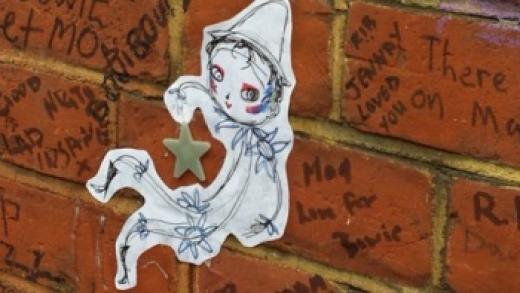......何謂 ˊPierro,據葉靈鳳的解釋,說這個字含有先驅者的意思,戲劇開場前身著彩衣插科打諢的報幕人,也可以稱之為ˊPierrot',用文藝點的話來說,....... ˊPierrot'一出現,必有一個新的局面,新的時代隨之而來,.......從象徵到現代 《戴望舒卷》 洪範,1977
https://www.facebook.com/hanching.chung/videos/4714454311992519
****
https://www.youtube.com/watch?v=xKyyTq_654M&t=11shttps://www.youtube.com/watch?v=xKyyTq_654M&t=11s
***
Pierrot, a character in pantomime, thievish, greedy, artless, and amoral; dressed in loose white garments, with his face whitened.
~ The Concise Oxford Dictionary of FRENCH LITERATURE.
***
David Bowie – Tears For A Clown

“I’m Pierrot, I’m Everyman. What I’m doing is Theatre and only Theatre...What you see on stage isn’t sinister, it’s pure clown. I’m using my face as a canvas and trying to paint the truth of our time on it. The white face, the baggy pants – they’re Pierrot, the eternal clown putting over the great sadness…” – David Bowie (1976)
“I'm Pierrot," said David Bowie: "I'm Everyman" Harry is dressed as Pierrot, a role that belonged to the italian comedy known as the “sad clown" of the ...
In 1976, he said in an interview: "I'm Pierrot. I'm Everyman. What I'm doing is theatre, and only theatre …
In short, Pierrot became an alter-ego of the artist, specifically of the famously alienated artist of the nineteenth and early twentieth centuries.[3] His physical insularity; his poignant lapses into mutism, the legacy of the great mime Deburau; his white face and costume, suggesting not only innocence but the pallor of the dead; his often frustrated pursuit of Columbine, coupled with his never-to-be-vanquished unworldly naïveté—all conspired to lift him out of the circumscribed world of the Commedia dell'Arte and into the larger realm of myth. Much of that mythic quality ("I'm Pierrot," said David Bowie: "I'm Everyman")[4] still adheres to the "sad clown" of the postmodern era.
Google : 總之,皮埃羅成為藝術家的
In short, Pierrot became an alter-ego of the artist, specifically of the famously alienated artist of the nineteenth and early twentieth centuries.[3]
Much of that mythic quality ("I'm Pierrot," said David Bowie: "I'm Everyman")[4] still adheres to the "sad clown" of the postmodern era.
詩人戴望舒心中的「丁香」姑娘是誰?
以「雨巷詩人」而馳名,繼而又領銜「現代」詩派的戴望舒,他的詩數量不豐、體式不宏、題材不廣,或許難當「雄沉博大」之評語,但放眼新詩風雨歷程,他又是繞不開的存在。連詩人余光中這樣對戴詩多有微詞者,也說他「上承中國古典的餘澤,旁採法國象徵派的殘芬,不但領袖當時的象徵派作者,抑且搖啟現代派詩風。」當那撐著油紙傘的詩人,那寂寥悠長的雨巷、那夢一般地飄過有著丁香一般憂愁的姑娘,那是多麼充滿象徵意味的抒情形象和意象。且看他的〈雨巷〉:
撐著油紙傘,獨自
彷徨在悠長,悠長
又寂寥的雨巷,
我希望逢著
一個丁香一樣地
結著愁怨的姑娘。
她是有
丁香一樣的顏色,
丁香一樣的芬芳,
丁香一樣的憂愁,
在雨中哀怨,
哀怨又彷徨;
她彷徨在這寂寥的雨巷,
撐著油紙傘
像我一樣,
像我一樣地
默默彳亍著,
冷漠,淒清,又惆悵。
她靜默地走近
走近,又投出
太息一般的眼光,
她飄過
像夢一般地,
像夢一般地淒婉迷茫,
像夢中飄過
一枝丁香地,
我身旁飄過這女郎;
她靜默地遠了,遠了,
到了頹圮的籬牆,
走盡這雨巷。
在雨的哀曲裏,
消了她的顏色。
散了她的芬芳,
消散了,甚至她的
太息般的眼光,
她丁香般的惆悵。
撐著油紙傘,獨自
彷徨在悠長,悠長
又寂寥的雨巷,
我希望飄過
一個丁香一樣地
結著愁怨的姑娘。
但這位「丁香」姑娘是確有其人,那是他的初戀情人,好友施蟄存的大妹施絳年。她比戴望舒小五歲,此時長得亭亭玉立。戴望舒當時匿居於施家,與施絳年有了更多的接觸,愛情的幼苗在詩人的心田萌生。戴望舒的初戀是痛苦的,使他更為痛苦的是他囿於傳統,自尊而又內向,胸有鬱積卻不能一吐為快,只能把自己的「真實」通過想像流瀉於詩篇之中。一九二九年四月,詩人自編的第一本詩集--《我底記憶》出版了,他在詩集的扉頁上大大地印了A Jeanne(給絳年)幾個法文字,並有兩行拉丁文的詩句,據戴望舒自譯為--
願我在最後的時間將來的時候看見你,
願我在垂死的時候用我的虛弱的手把握著你。
詩人把自己對施絳年的感情公開了,把自己絕望的愛戀公開了。它表露詩人整個痛苦的靈魂,也為這本小小的詩冊增加了感情的深度與重量。當然這段愛情是沒有結果的。
沒有留言:
張貼留言